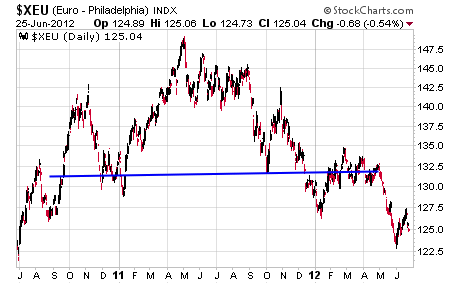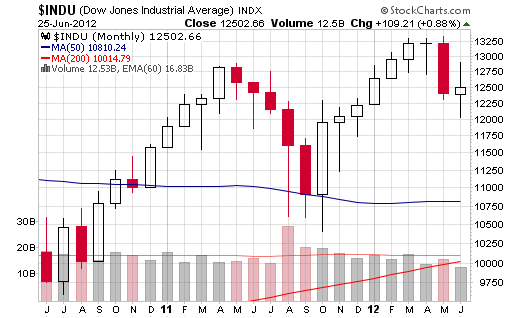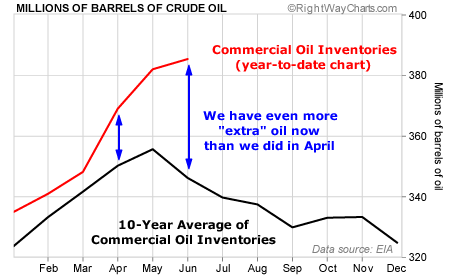Personal Finance
Dr. Michael Berry is a pioneer in the emerging field of “discovery investing.” He researches and writes on companies that focus on discovery in natural resources, high technology and biotech. He publishes Morning Notes by Michael A. Berry, Ph.D. The notes discuss geopolitics and their effect on capital markets. Dr. Berry served as an Executive of Horseshoe Gold Mining, Inc. Dr. Berry served as a Financial Consultant to mining companies, as well as an investment advisor and researcher since 1984. He advised the governments of Canada, China and Costa Rica, as well as the World Bank, Mellon Bank, USAID, The Work Bank, CitiCorp. and Solomon Brothers. Be sure to tune in at CKNW 980 at 8:30 am PST, or listen online live at http://player.cknw.com/

Below, the euro — Is that a monster head & shoulders top that I see?

This is a monthly chart of the Dow going back two years. Note the volume dropping off bearishly on the climb from the September low. The diminishing volume suggests that the bear market will be extended and deceptive. I am using the monthly Dow to eliminate all intra-month movements, which could be confusing. I believe the continuing bear market will be expressed by a long series of monthly declines in the Dow — just as the rise from the September low was expressed by a series of rising Dow monthlies.

Below is a sensitive chart showing the percentage of NYSE stocks holding above their 50-day moving averages. The percentage now is down to 29.9%, meaning that 70% of the stocks on the NYSE are now trading BELOW their 50-day moving averages — and the percentage has been dropping off as we move along.
Despite these pictures of what is actually happening, I note that many big-name analysts are bullish. For instance, the famous Meredith Whitney states that she is “wildly bullish on the US.” She may be correct in her opinion, but I go by the stock market’s opinion. The chart just above hardly backs the case for “wild bullishness,” but if the evidence changes, I hope to be nimble and unprejudiced enough to change with it.
I’m not kidding myself, this is a devilishly difficult market to deal with or analyze. My work shows that we are in a tricky and deceptive bear market. The evidence, as I write, remains bearish. Furthermore, the economic news remains bearish, despite all the public relations efforts to give the news a bullish slant.

Interested in Subscribing? Go HERE
|
Russell began publishing Dow Theory Letters in 1958, and he has been writing the Letters ever since (never once having skipped a Letter). Dow Theory Letters is the oldest service continuously written by one person in the business. Russell gained wide recognition via a series of over 30 Dow Theory and technical articles that he wrote for Barron’s during the late-’50s through the ’90s. Through Barron’s and via word of mouth, he gained a wide following. Russell was the first (in 1960) to recommend gold stocks. He called the top of the 1949-’66 bull market. And almost to the day he called the bottom of the great 1972-’74 bear market, and the beginning of the great bull market which started in December 1974. The Letters, published every three weeks, cover the US stock market, foreign markets, bonds, precious metals, commodities, economics –plus Russell’s widely-followed comments and observations and stock market philosophy. In 1989 Russell took over Julian Snyder’s well-known advisory service, “International Moneyline”, a service which Mr. Synder ran from Switzerland. Then, in 1998 Russell took over the Zweig Forecast from famed market analyst, Martin Zweig. Russell has written articles and been quoted in such publications as Bloomberg magazine, Barron’s, Time, Newsweek, Money Magazine, the Wall Street Journal, the New York Times, Reuters, and others. Subscribers to Dow Theory Letters number over 12,000, hailing from all 50 states and dozens of overseas counties. A native New Yorker (born in 1924) Russell has lived through depressions and booms, through good times and bad, through war and peace. He was educated at Rutgers and received his BA at NYU. Russell flew as a combat bombardier on B-25 Mitchell Bombers with the 12th Air Force during World War II. One of the favorite features of the Letter is Russell’s daily Primary Trend Index (PTI), which is a proprietary index which has been included in the Letters since 1971. The PTI has been an amazingly accurate and useful guide to the trend of the market, and it often actually differs with Russell’s opinions. But Russell always defers to his PTI. Says Russell, “The PTI is a lot smarter than I am. It’s a great ego-deflator, as far as I’m concerned, and I’ve learned never to fight it.” Letters are published and mailed every three weeks. We offer a TRIAL (two consecutive up-to-date issues) for $1.00 (same price that was originally charged in 1958). Trials, please one time only. Mail your $1.00 check to: Dow Theory Letters, PO Box 1759, La Jolla, CA 92038 (annual cost of a subscription is $300, tax deductible if ordered through your business). IMPORTANT: As an added plus for subscribers, the latest Primary Trend Index (PTI) figure for the day will be posted on our web site — posting will take place a few hours after the close of the market. Also included will be Russell’s comments and observations on the day’s action along with critical market data. Each subscriber will be issued a private user name and password for entrance to the members area of the website. Investors Intelligence is the organization that monitors almost ALL market letters and then releases their widely-followed “percentage of bullish or bearish advisory services.” This is what Investors Intelligence says about Richard Russell’s Dow Theory Letters: “Richard Russell is by far the most interesting writer of all the services we get.” Feb. 19, 1999. Below are two of the most widely read articles published by Dow Theory Letters over the past 40 years. Request for these pieces have been received from dozens of organizations. Click on the titles to read the articles. |
Quote
“Today, we pay tribute to the pagan god of token environmentalism by spending countless hours recycling paper.” –Bjorn Lomborg, Adjunct Professor at the Copenhagen Business School, writing in July/August 2012 Foreign Affairs, “Environmental Alarmism, Then and Now.”
Headlines & Of Interest
10 Reasons Countries Fall Apart (Foreign Policy)
Egypt: O brother, where art thou? (Asia Times; Pepe Escobar)
Commentary
We get a sense global liquidity is draining back to the center from the periphery. We know we are not alone in this view, as many have warned about the European banking system’s deleveraging globally i.e. reducing loan exposure. Add in the tepid global growth environment with all three wagon pullers—US, Europe, Asia—now struggling, and we have the recipe for a systemic event. Though the Eurozone is ground zero for triggering such risk, especially now that Chancellor Merkel (rightly so) ruled out debt sharing, it is quite possible the catalyst could be an emerging market economy first, and Eurozone second. Any EM event will likely trigger even faster global deleveraging from the private sector, including those investors who continue to be sold the fantasy that EMs have decoupled.
Action
Technically, we think a longer term top is in place; made back in 2007. If we see some contagion in EMs, the next leg down could be swift and deep!

In the last two months, the benchmark U.S. crude oil price has dropped more than 20%.
And it’s not done falling.
As regular Growth Stock Wire readers may remember, I began writing about a collapse of the price of crude oil back on April 4. At the time, oil prices were still up around $105 per barrel.
Back then, I noted how the huge and growing U.S. oil inventories, coupled with growing U.S. production, would cause prices to drop. Since then, the price of crude oil has fallen below $80. Last week alone, we saw prices decline 6%.
Today, I’ll show you why I think oil prices are going even lower…
The fundamentals of supply and demand remain out of balance in the oil market. Two months ago, I showed you how much more oil we had in storage than the 10-year average. Here’s an updated chart…
You can see things have gotten even more extreme.

| One important point to note is that usually, the oil in storage is declining by June as the summer driving season kicks in.
This year, according to the Energy Information Administration’s data, the volume of oil in storage is still rising into the summer. It hit 387.3 million barrels at the end of last week. That’s 11% more than it was when we checked in April. And it’s 12% above the average for this time of year. In other words, the world’s largest oil consumer has a lot more oil around than it usually does. So supply is up, what about demand? Turns out demand is way, way down. Gasoline constitutes 42% of oil demand here in the U.S. So we can use the volume of gasoline supplied by refiners as a rough gauge. In April, which is the latest data available, we see the gasoline consumption was about 344.6 million gallons per day. That’s the lowest consumption for the month of April since 1997. Demand is not only failing to keep pace with the huge new supplies coming online… it’s actually falling. It was a recipe for lower oil prices two months ago. The same is true today. I don’t know exactly how far it could fall, but $70 or $60 is easily possible in the next six months. Good investing, Matt Badiali P.S. Yesterday, my colleague Jeff Clark showed you how oversold oil stocks are right now. He’s expecting a short-term bounce soon. He might be right. But I believe the long-term trend is still down. Unless you’re a trader, you should probably be out of oil stocks here. |
|
















